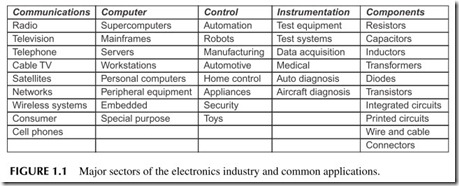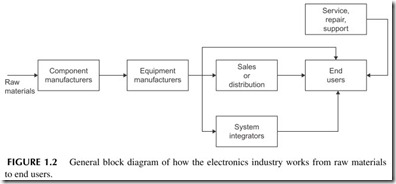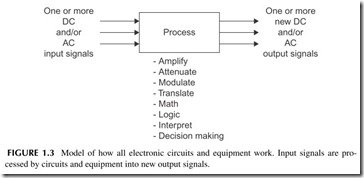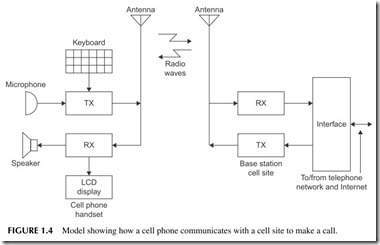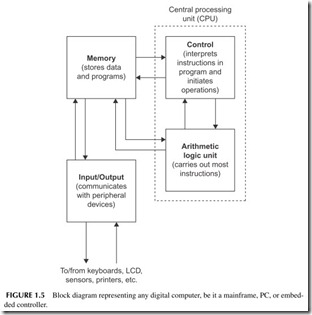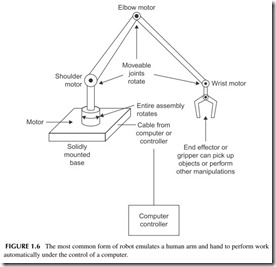Learning about Electronics for Your Own Good
INTRODUCTION
You don’t know how lucky you are. You live in high-tech heaven surrounded by lots of useful, entertaining, interesting, necessary, and even addicting elec- tronic products, products you cling to and would not want to give up.
But do you have any idea how many electronic products you own? Do you really know how much electronics influences your life every day? Some of you do, but most of you probably do not because your electronic gadgets are pretty much taken for granted. Yet we spend the better part of our lives working with these devices. Most of us sit in front of a computer all day at work, slouch on the couch in front of the TV at night, listen to our iPods going to and from work, and spend a weekend downloading videos off of the Internet or taking photos with a digital camera. And let’s be clear here, how many text messages did you send today or cell calls did you make? The impact on our lives of all this electronic equipment is almost overwhelming. In this first chapter, I encourage you to think about how electronics impacts your life.
And that brings us to the subject of this book, learning how electronics works. If you want a first book in electronics that gives you the big picture about how electronic equipment works, this is it. I am not going to beat you to death with a lot of complex circuits and theory or math, only what you really need to know. Then I will go on to show you how each and every one of the products you use every day actually works.
IT ISN’T LIKE IT USED TO BE
It used to be that you learned electronics by playing around with resistors, capacitors, transistors, and other devices. You wired up simple circuits, built a one- or two-transistor radio, or even built a kit. But today electronics is so different that it is hard to do that anymore. Oh yes, you can still build little circuits and radios and other gadgets, but that is not how electronic products are made today. Electronic equipment today is made with integrated circuits or ICs that we also call chips. These chips are tightly packed on printed circuit boards with resistors and capacitors that you can barely see. It is more difficult than ever to experiment with these devices, much less troubleshoot and repair them. We are in that age of electronics where unless it is a big pricey piece of equipment, you throw a defective electronic product away and simply buy a newer and better one at a lower price.
But despite the complexity of today’s electronic products, there is some- thing just fascinating about them. Many of you actually want to know how they work. And despite their complexity, these products are actually understandable. It is possible to learn how these devices work without a whole lot of trouble. And you don’t have to learn all the math and physics required by engineers to do so. This book takes the basic ideas of electronics and reduces them down to the lowest common denominator and shows you how to use those fundamentals and apply them to all of the fabulous electronic gadgets you have today.
WHAT’S IN IT FOR YOU?
There are some big benefits to being electronic literate. Take a look at some of them.
Satisfy Your Curiosity—Surrounded by so much electronics, you often probably wondered just how all this stuff works. For some of us, not know- ing how something works nags at us until we satisfy that curiosity. If you have an interest in electronics, you tend to want to know more about it. This book will get you started in the right direction.
Enhance Your Hobby—If you dabble in a hobby that uses electron- ics, you obviously want and need to know more about it. Lots of hobbies involve electronics such as radio-controlled models, electric trains, ama- teur radio, shortwave listening, citizens or family radio, audio systems, or video. Or maybe you just like playing around with your home security sys- tem, garage door opener, or your high-speed Internet connection. A major part of any hobby is learning more about it and that is very satisfying. And don’t forget—electronics itself can be your hobby. You can spend your time learning more about it and then digging deeper into those things that you want to know more about. Amateur radio is certainly one of those elec- tronic hobbies that will take you from one extreme to the next in the radio spectrum. Anything having to do with computers is also a great hobby.
With everything being controlled by an embedded microcomputer, spend- ing more time learning about them is a great activity with nearly endless possibilities.
Job-Related Needs—You may actually be working in a job surrounded by electronic equipment of some sort, yet you do not know how it works. Often, just understanding some of the fundamentals will give you a bet- ter grasp of how to use that equipment or even troubleshoot and repair it. Understanding some of the concepts may actually help you to better select and purchase equipment that you may use.
Boost Your School Performance—For those of you going to a college or university to learn electronic engineering or technology, you regularly have your curiosity stimulated by the classes you take. Yet most of the classes are heavily involved with theory, physics, math, and circuit analysis. What you really don’t get in school is the perspective or big picture as to how the electronic products actually work. This book will give you the big picture and show you how it all comes together so that all those detailed classes in circuits and theory will make more sense.
Just so You Won’t Appear to Be So Dumb—With electronics every- where, people often talk about it without really knowing what they are talking about. It is amazing the ignorance of people who use the electronics but don’t have a clue as to what it does or how it does it. For instance, do you really understand what an MP3 is, or why BluRay DVDs are better, or what a 3G cell phone really is? The answers are in this book. If you want to appear a little smarter to your co-workers, friends, and relatives, this book can help out. You will be able to deal with common questions and miscon- ceptions, such as can you get shocked by a car battery, can you really get brain cancer or pop popcorn with your cell phone, or will sitting too close to your TV set make you sterile? While this book certainly won’t make you a genius, it will indeed give you the basics so that you won’t appear to be an idiot when technical questions about electronics come up.
ELECTRONICS: THE BIG PICTURE
Before we get into the nitty-gritty of how electronic equipment works, you really need to know the entire scope of electronics. It is a huge industry and recent figures seem to show that it is one of the biggest, if not the biggest, markets in the entire world. To get a grasp of how big the industry is, we nor- mally break it down into segments of specializations. There are five major fields of electronics: communications, computers, control, instrumentation and measurement, and components. Any electronic product or device will easily fall into one of those categories. In some cases, the product may overlap two or more or all of those categories. Take a look at Figure 1.1 , which shows each of these segments of electronics and the products and technologies that are part of them.
Communications
Communications is the oldest segment of electronics and still the largest. Electronics actually started with communications–specifically telegraph, tele- phone, and radio–and grew from there. A lot of this book is about communi- cations because it is such a huge segment of the industry and one that we use the most. And don’t forget, communications comes in both wired and wireless forms. Wired systems include the vast telephone network, cable TV systems, and computer networks, including the Internet. Wireless systems comprise all of the radio, cell phone, television, satellite, radar, and other wireless systems.
Computers
Computers have only been around since the late 1940s and early 1950s but what an impact they have had on the way we work. Today virtually everyone uses and even owns a personal computer. And then there are all the larger and more powerful computers such as the servers that manage all of our networks, the mainframes still used by government and big business to manage huge databases, as well as the high-speed supercomputers that still do an amazing amount of scientific, engineering, and mathematical design and research. But the computer we are going to talk about most in this book is the embedded controller. These are small single-chip digital computers called microcomputers or just micros that are literally part of every electronic product. These are miniature digital computers dedicated to a specific function inside the products in which they exist.
Control
Control is a broad general term for monitoring and control. Monitoring, of course, means sensing various physical characteristics such as temperature, humidity, physical position, motor shaft speed, or light level. Electronic devices called sensorsor transducers convert these physical characteristics into electrical signals
which allow us to monitor them. Control refers to managing and exercising some degree of influence over items such as motors, lights, relays, heating elements, and other devices. Most monitoring and control functions take place in factories, chemical plants, refineries, and food processing operations. Control also occurs in the home, an example being your electronic thermostat. It also shows up in electromechanical products like a DVD player. Electronic controls appear in appliances, home control systems, security systems, automobiles, and even toys. Robots are another major segment of the control industry.
Instrumentation
Instrumentation refers to the field involved with testing and measuring elec- tronic equipment and other mechanical or electronic items. It refers to the test instruments like volt meters, oscilloscopes, and spectrum analyzers as well as the large automated test systems used for mass testing and measuring of other devices. Instrumentation refers to data acquisition systems, medical tests and measurements, and a wide range of other products.
Components
All of the electronic products that make up each of the four major segments of the electronic industry are made up of various electronic components. In the past, electronic products were made of the individual discrete components such as resistors, capacitors, diodes, and transistors. Today most electronic equipment is made with one or more integrated circuits surrounded by a sprin- kling of those other so-called discrete components. No longer can we access most individual components or circuits since they are sealed within integrated circuits or chips. Just keep in mind that there is a whole industry centered on making these electronic components that are in turn made available to the manufacturers of the end electronic equipment in each of the four major cat- egories just described.
HOW THE ELECTRONICS INDUSTRY WORKS
As part of the big picture of learning electronics, you really need to under- stand how the industry itself works. This is summed up by the simplified block diagram in Figure 1.2. It all starts with the raw materials that the component manufacturers use to create the individual components. For example, sand is refined into silicon, which, in turn, is converted into wafers that are processed into the integrated circuits we use.
The electronic equipment manufacturers design the electronic equipment for the marketplace. It may be a TV set, a cell phone, or a military radar. These companies buy the electronic components and put them together to create the
end product. Manufacturers may then sell the end product directly to cus- tomers and end users. In some cases, the end product will go through a sales organization or distributor of some sort. Your LCD large-screen TV set doesn’t come directly to you directly from Samsung in Korea or Sony in Japan. It is sold to an organization such as Best Buy or Circuit City, which is where you buy it. Sometimes the electronic equipment is sold to so-called systems inte- grators. These are companies that piece together larger systems for an end user (like the military) made up of a wide range of different types of equipment.
Finally, there are the customers or end users of the equipment. These come from a wide range of backgrounds. The end users or customers may be busi- nesses with offices, industry with factories and process control plants, or the government, military, hospitals and other medical organizations, schools, col- leges and universities, and you the consumer. There is also a network of serv- ice companies designed to support customers. They may do installation or repair work that the customer is not capable of doing.
Electricity versus Electronics
One of the questions that always comes up in the early stages of learning about electronics is what the difference is between electricity and electronics. Let’s get this straight up front. Electricity refers to the basic energy we use for power. It generally involves the generation and distribution of electrical energy to homes, businesses, and factories. Electricity is energy that is produced by the coal-fired or nuclear power plant and then sent to you over long transmis- sion lines until it comes into your house where you access it through your AC wall outlets. You use that energy for lighting and appliances, and also to power most of your electronic equipment.
Electrical power may also be generated for use in other systems. The elec- trical system in a car is a great example. It uses a battery plus a generator driven by the automobile engine to recharge the battery and to operate all of the electrical
and electronic devices in a car. Ships, airplanes, and off-shore drilling rigs also have their own electrical-power generating systems. The new electric wind gen- erators and solar power systems are also electricity-producing systems.
All of the principles of electricity also apply to electronics. Basic electrical components such as resistors, capacitors, inductors, transformers, motors, and other similar devices are also used in electronics.
Electronics is the field of science that uses electrical principles to per- form other useful functions. Electronics is the control of electricity to produce radio, television, computers, robots, and MRI machines. To control the elec- tricity, you need more than just basic electrical components such as resistors and capacitors. What makes electronics possible are the unique components called transistors. Electronics began, of course, with vacuum tubes and then switched over to transistors as the main control devices. Transistors are now miniaturized and packaged in devices called integrated circuits that perform very specific electronic functions, such as generating signals, amplifying sig- nals, or performing some control function. Just keep in mind that it is the con- trol devices such as transistors and the circuits that they comprise that make electronics what it is. The transistors are used to form circuits that in turn per- form all of the various functions required to produce electronic devices.
THE PAINFUL TRUTH
Okay, here comes the hard part. Electricity is moving electrons. An electron is a tiny particle that is inside the atoms that make up everything we can feel, see, and even not see. If we can get some electrons moving together in a wire, electrical or electronic component, or circuit, we can control them to do many useful things, such as amplification, for example. Moving electrons make up what we call current flow. And current flow is produced by electrical energy called voltage. Voltage comes from batteries, the AC wall outlet, and lots of other sources including power supplies, solar cells, microphones, and the like. If we can control the electrons we can produce magic results. That is what electronics is all about.
We control the electrons with components like resistors, capacitors, induc- tors, transistors, and all sorts of integrated circuits. We create circuits that actu- ally process the electron flow. We can call the voltages that create current flow and the resulting current signals. The circuit processes the signals to produce the end effect that we want, be it a radio, a computer, or DVD player.
One of the basic models I will use in this book is shown in Figure 1.3. Think of electronic signals as the inputs to a circuit or piece of equipment that processes the signals producing new signals that represent the output we want. Think of the small voltage that comes from a microphone when you talk into it. It is basically too small to be useful. So we apply it to a circuit called an amplifier that makes the signal bigger and more useful. That amplifier processes the signal to make it large enough to drive a speaker as our desired
output. The result is a public address system. Anyway, you get the picture. Just remember that all electronic circuits and equipment are based on this model: INPUT-PROCESS-OUTPUT. Think about it.
Here are a couple of other examples to show how most electronic things work.
Cell Phone
Take a look at Figure 1.4. On the left is a cell phone handset. It is made up of two major pieces–a transmitter (TX) and a receiver (RX). You talk into a microphone and generate a small electrical voltage or signal representing your voice. The transmitter takes that and processes it in such a way that the voice controls or modulates a high-frequency radio signal. That signal carrying your voice is then radiated by the antenna to a cell site or base station. The base station receiver picks it up and processes it back into the original voice signal where it then undergoes other processing before being sent over the telephone network to its destination. The dialing process or text messaging from the key- board also generates input signals that are transmitted to the base station.
On the return side, the voice from your caller passes through the cell phone network to the base station and it is then used to control the transmitter to send that voice to you by radio. The transmitter sends the signal to the antenna that sends the signal to the receiver in your cell phone. The receiver processes the signal by amplifying, demodulating, and otherwise processing the voice that eventually is sent to the speaker that is glued to your ear. Another output may be a text message on the liquid crystal display (LCD).
Computers
The main function of a computer is to store and retrieve data, process data, and to provide automatic control. Data consists of information, facts, and figures. It may be numbers, letters, symbols, or text of any kind. It might represent
names and addresses, parts inventory, accounting or banking figures, control signals, or a variety of other items. Data may also be graphics and illustrations, or voice and video that are converted to data. Such data can be stored electron- ically in computers and rapidly accessed.
Computers process or manipulate data in many different ways. They can perform mathematical operations on it, sort it, edit it, translate it, or otherwise operate upon it to produce some useful output. Computers also make decisions based on the data.
Computers have so many applications that it is difficult to enumerate them. In general, computers are tools that help people organize and perform their work in a more efficient manner. Computers also allow people to do work that was difficult or impossible to do without computers. Computers perform accounting and banking operations; store and process mailing lists and employee records; solve complex mathematical problems in business, science, and engineering; and create graphics. The thing that makes them so valuable is that all of their operations are automatic. Humans need not be a part of the actual computation, as is necessary with a calculator. Computers carry out preprogrammed assign- ments to solve various problems or perform operations. Most operations are extremely fast. It is this automatic feature that makes computers so useful.
All computers, regardless of their size and features, are made up of the four basic sections shown in Figure 1.5. The memory electronically stores the data to be processed, as well as the program that tells how the data is to be manipu- lated. The program is a sequence of codes or instructions that cause the com- puter to carry out its preprogrammed assignment one step at a time.
Refer again to Figure 1.5. The control section examines the program instructions one at a time in sequence, interprets them, and then sends control signals to all other parts of the computer. The desired operations, such as store, add, print, and so on, are carried out.
The arithmetic logic unit (ALU) is the section that actually carries out most of the processing. It performs data transfers, arithmetic operations, and logical decision making. In most computers, the control and ALU sections are inte- gral units that work closely together. They are usually referred to as the central processing unit (CPU). A microprocessor in a personal computer is a single chip or central processing unit.
The input/output (I/O) section in Figure 1.5 is the interface between the computer and the outside world. It communicates with peripheral devices that humans use to input programs and data, and receive the output results of com- putation. Data and instructions are usually entered via a keyboard, while outputs
are displayed on a video screen or printed out. Inputs may come from sensors and output may go to a printer or LCD readout.
There are many sizes and types of computers. Supercomputers are the largest and fastest computers. They are used primarily for difficult, complex scientific and math problems. Mainframe computers are also very large, and they are used by business and government for financial applications, data storage, and other applications. Personal computers are the smallest practical computers in use. Millions of them are used for word processing, financial spreadsheets, database management, and email and Internet access.
There are also many dedicated computers, built into other equipment to perform single-purpose operations unlike the general-purpose data processors described above. Thanks to semiconductor technology, it is now possible to put an entire computer on a single chip you can hold in your hand. These are called embedded computers, or microcontrollers. These microcomputers are used like components and are built into most other kinds of equipment such as TV sets, microwave ovens, gasoline pumps, washing machines, and many others. Virtually every other electronic product contains at least one or more embedded controllers. And even very large ICs have controllers on the same chip called cores.
Robots
A great example of a control device is a robot. Most robots consist of an elec- tromechanical manipulator arm used in manufacturing operations. Robots are machines designed to mimic human capabilities. Most robots simulate a human arm and hand. As a result, a robot may be able to substitute for a human in certain manufacturing jobs. A typical robot manipulator arm is shown in Figure 1.6. Motors operate shoulder, elbow, and wrist joints, while grippers and other tools form the hand that does the work.
Robots help automate the manufacturing process to increase productiv- ity. They lower costs, produce more goods in less time, and improve quality. Robots also replace humans in many jobs requiring repetitive, tedious, and hazardous work.
Robots perform a variety of tasks in industry. The most common are welding, spraying or painting, and “pick-and-place” operations. Various tools on the end of the manipulator arm, called end effectors, let the robot per- form a remarkable variety of tasks. In addition, a programmable controller or computer is used to control the robot. A robot may thus be programmed to perform a wide variety of jobs and is easily reconfigured when the work changes.
In subsequent chapters you will see more of these kinds of descriptions. But in Chapters 2, 3, and 4, you will learn a few more basics that make the rest of the book more understandable.
Project 1.1
How Much Electronics Do You Own?
Just to be sure that you really appreciate the extent to which electronics impacts your life, I strongly suggest that you take a few minutes and make an inventory of all the electronic devices and equipment that you use at home, at work, and away from home. Get a yellow pad and a ballpoint pen and move around your house and just write down all the electronic products that you own and use on a regular basis. TV sets, computers, and cell phones are the most obvious, but don’t for- get things like telephones, your wrist watch, appliances, and other entertainment products. Make a separate listing of the electrical and electronic products you use inside your car and then another one for those electronic products that you use at work. Make the list comprehensive. Study it. Be amazed.
Project 1.2
How Much Electronics Do You Use?
Now take that same pad of paper and pen and make a quick summary of how you spend your time during the day. How much time do you spend using each of the electronic products that you listed above? Some of them are only momentarily used, but others you use over longer periods of time, particularly computers and TV sets. Just take a quick estimate of the time you use each one during a typical day. Again, add up the hours. Be amazed.
Project 1.3
Decisions, Decisions
Make the following decision. If you had to give up all of your electronic products but one, which one would you keep? TV, cell phone, remote control, iPod? Only one. This will say a lot about who you are.
